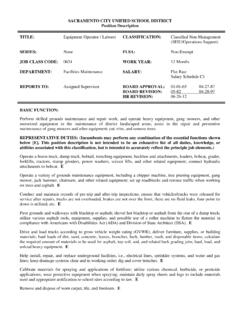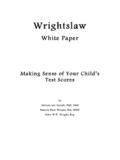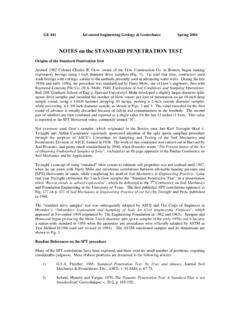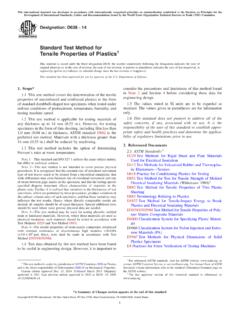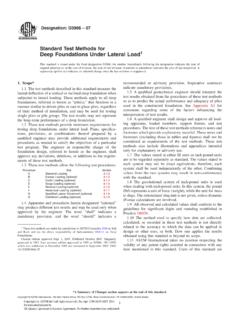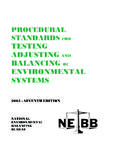Transcription of The CogAT Test Explanation for Parents
1 1 Reading the CogAT Report for Parents The CogAT Test measures the level and pattern of cognitive development of a student compared to age mates and grade mates. These general reasoning abilities, which start developing at birth and continue through early adulthood, are influenced by experiences gained both in and out of school. The CogAT measures three different cognitive abilities. The verbal section measures a child s ability to remember and transform sequences of English words, to understand them and to make inferences and judgments about them.
2 The quantitative section measures a child s understanding of basic quantitative concepts and relationships. The non-verbal section measures reasoning using pictures and geometric shapes. This section reduces the impact of language on the student s score. The composite score is a total score for all three batteries. Age Scores The test uses age norms (national) and grade norms (national) to calculate scores and compare students of the same age or grade. The local scores compare students in the same school system. This section of the report is dedicated to students age scores.
3 Students are grouped by age in one-month intervals from 4 years 11 months through 18+ years of age. The first column in the Age Scores section, the Standard Age Score (SAS) scale is a normalized standard score scale for each battery and the Composite. The SAS has a mean of 100 and a standard deviation of 16. It permits educators to compare the rate and level of cognitive development of an individual to other students in the same age group. For example, students who have an SAS of 100 on the Verbal Battery have a rate and level of development of verbal reasoning skills that is typical of their age group.
4 A student who has an SAS of 125 on the Verbal Battery has a faster rate and a higher level of development of verbal 2 reasoning skills than the typical student in the same age group. The SAS scale provides fine discriminations among high- and low-scoring students. The second column in the Age Scores section shows the Stanine Age Score. The stanine scale is a normalized standard score scale consisting of nine broad levels designated by the numbers one through nine. Stanine scores range from a low of 1 to a high of 9. Stanines are groupings of percentile ranks.
5 A higher stanine equates with a higher level of cognitive abilities development. A comparison of Stanines and Percentile Ranks are summarized in the table below: Stanine Percentile Rank Description 9 96-99 Very High 8 89-95 Above Average 7 77-88 Above Average 6 60-76 Average 5 40-59 Average 4 23-39 Average 3 11-22 Below Average 2 4-10 Below Average 1 1-3 Very Low The third column in the Age Scores section shows your student s Age Percentile Rank for each section and the composite (once again the national percentile rank). A percentile rank indicates the percentage of students in the same age group whose scores fall below the score obtained by a particular student.
6 For example, if your student obtains a percentile rank of 90 on 3 the verbal battery, it means that 90 percent of students in the standardized sample scored below your student. A percentile rank of 50 is considered average. APR Scores-Age Percentile Graph This section also relates to your student s AGE scores. It is a graphic representation of your student s scores for each of the batteries and the composite. Scores for each section of the assessment are indicated by a diamond shape within a score band. The score band represents the confidence interval.
7 The confidence interval is dependent upon individual error scores. Error scores represent the error of measurement for each student. These things affect error scores: student responds inconsistently to items in the same battery ( if the student misses easy items but correctly solves difficult items) the student does well on one subtest in a section of the test but poorly on another subtest in the same battery Score Profile Based on the score information in this section, a score profile is created for your student. Example _____ability profile is 6B (N-).
8 This is where you are directed to the Interactive profile system. You are expected to enter your child s profile score in the input section and directed to hit search. 4 Raw Scores The next section contains three sections. The Raw Scores give you the number of items on the test, number attempted, and the number correct in each test section. The Grade Scores The Grade Scores are defined as above (see Stanine and PR Explanation except that they refer to the National Percentile Rank of students in the same grade level across nation.)
9 Local Scores The Local Scores are defined as above (see Stanine and PR Explanation above) except that they refer to the Local Stanine and Percentile Rank meaning the scores of students in the same school system. 5 Composite Score The number indicating the Composite Score is a percentile for all three sections. This number combines all three scores and indicates where your child stands by comparison to other students who took the test. Thus, a composite percentile score of 98 indicates that, overall, your child did better on all three sections combined than 98 percent of other students in her age group.
10 Understanding Score Profiles Since CogAT s inception, the authors have encouraged teachers to focus on the student s scores on the three separate CogAT batteries rather than on the student s Composite score. The scores on the three batteries make up a student s score profile. CogAT score profiles identify both the level of the student s scores and the pattern of scores across the batteries. In the short paragraph at the bottom of the page, you ll see an Ability Profile. You can use this profile code at the website to receive more information about the CogAT test and your daughter s or son s scores.


